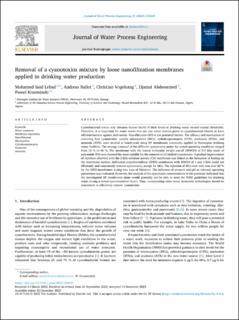| dc.contributor.author | Lebad, Mohamed Said | |
| dc.contributor.author | Ballot, Andreas | |
| dc.contributor.author | Vogelsang, Christian | |
| dc.contributor.author | Abdessemed, Djamal | |
| dc.contributor.author | Krzeminski, Pawel | |
| dc.date.accessioned | 2024-02-29T14:35:54Z | |
| dc.date.available | 2024-02-29T14:35:54Z | |
| dc.date.created | 2023-12-30T12:23:44Z | |
| dc.date.issued | 2023 | |
| dc.identifier.citation | Journal of Water Process Engineering. 2023, 57, 104694. | en_US |
| dc.identifier.issn | 2214-7144 | |
| dc.identifier.uri | https://hdl.handle.net/11250/3120525 | |
| dc.description.abstract | Cyanobacterial toxins may threaten human health if their levels in drinking water exceed certain thresholds. Therefore, it is important for water works that use raw water sources prone to cyanobacterial blooms to have efficient barriers against such toxins. Nanofiltration (NF) is one potential barrier. The efficacy and mechanism of removing four cyanotoxins, namely microcystins (MCs), cylindrospermopsin (CYN), saxitoxins (STXs), and anatoxin (ATX), were studied at bench-scale using NF membranes commonly applied in Norwegian drinking water facilities. The average removal of the different cyanotoxins under the tested operating conditions ranged from 15 % to 96 %. The membrane with the lowest molecular weight cut-off (MWCO) of 0.3 kDa made of polyamide (PA) was deemed the most suitable for the removal of all studied cyanotoxins. A gradual improvement of rejection observed with the 2 kDa cellulose acetate (CA) membrane was linked to the formation of fouling on the membrane surface. Sulfonated polyethersulfone (SPES) membranes with MWCO of 1 and 3 kDa could not efficiently and consistently remove cyanotoxins, except for MCs. The rejection of MCs over time was over 80 % by the SPES membranes during two days of filtration. The influence of pressure and pH as relevant operating parameters was evaluated. However, the analysis of the cyanotoxin concentrations in the permeate indicated that the investigated NF membranes alone would generally not be able to meet the WHO guidelines for drinking water during a severe cyanobacterial bloom. Thus, incorporating other water treatment technologies should be considered to effectively remove cyanotoxins. | en_US |
| dc.language.iso | eng | en_US |
| dc.publisher | Elsevier | en_US |
| dc.rights | Navngivelse 4.0 Internasjonal | * |
| dc.rights.uri | http://creativecommons.org/licenses/by/4.0/deed.no | * |
| dc.title | Removal of a cyanotoxins mixture by loose nanofiltration membranes applied in drinking water production | en_US |
| dc.type | Peer reviewed | en_US |
| dc.type | Journal article | en_US |
| dc.description.version | publishedVersion | en_US |
| dc.rights.holder | © 2023 The Authors | en_US |
| dc.source.pagenumber | 13 | en_US |
| dc.source.volume | 57 | en_US |
| dc.source.journal | Journal of Water Process Engineering | en_US |
| dc.identifier.doi | 10.1016/j.jwpe.2023.104694 | |
| dc.identifier.cristin | 2218165 | |
| dc.relation.project | Norges forskningsråd: 300473 | en_US |
| dc.source.articlenumber | 104694 | en_US |
| cristin.ispublished | true | |
| cristin.fulltext | original | |
| cristin.qualitycode | 1 | |

